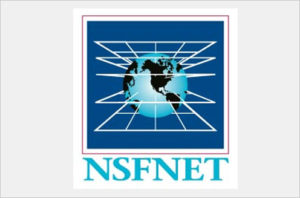
Date: 01/01/1995
NSFNET Program takes next steps in advancing networking
Marking a new phase for the Internet, the NSFNET Backbone was decommissioned at midnight on April 30, 1995. The National Science Foundation, which established the NSFNET Program in 1985, began an effort two years ago to privatize the backbone functions. With the transfer complete, the current backbone is no longer necessary.
The NSFNET Program will continue to lead in the development of new technology and new applications in networking for the research and education community, with the emphasis placed on bandwidth-intensive networking.
To establish the NSFNET Backbone, the proposal submitted by MERIT to the NSFNET Program was founded on the belief that a national research network is crucial for the future of scientific research in the United States. MERIT proposed a partnership with IBM and MCI to provide backbone services and advance networking technologies. The backbone connected NSFfunded regional networks and Supercomputer Centers, making it possible for research and education institutions to connect to regional networks and gain access to each other and to resources such as the Supercomputer Centers. Until now, the backbone has been funded by the NSF.
Creation of the NSFNET Program spawned a new industry, encouraging the growth of electronic networks that collectively are known as the Internet. The Internet continues to evolve, and the NSFNET Program will continue to support the technologies and connections that help advance this evolution.
“The NSF has been successful in promoting the use of networking among and beyond the research and education community. This has changed the nature of collaboration, and facilitated new opportunities in research and education,” said Priscilla Huston, Program Director for the NSFNET Program.
“The commodity services that were supplied by the NSFNET Backbone can now be acquired in the commercial sector. The NSFNET Program will work to advance the technology and the tools for bandwidth-intensive networking which will meet new applications needs.”
The NSFNET Backbone service has been managed by Merit Network, Inc. since 1987 in partnership with IBM and MCI. In 1990, the partnership formed a new non-profit corporation called Advanced Networking Services, Inc. that was awarded a subagreement by Merit Network, Inc., to provide and operate the NSFNET Backbone.
“The success of this project has been phenomenal. Merit forged an exemplary partnership with IBM, MCI and the State of Michigan Strategic Fund, which serves as a model for university, industry, and state and federal cooperation. Each of the participants contributed key expertise and resources and together, under Merit’s leadership, led the research and education community into a new era,” said Jane Caviness, interim director of the division of Networking and Communications Research and Infrastructure at the NSF.
Speaking for the partnership, Merit’s President Eric Aupperle praised the leadership of the National Science Foundation.
“We are pleased and excited to have been the team behind the extraordinarily successful backbone activity for the last seven years,” Aupperle said. “It’s rewarding to witness the results of our collaboration as the Internets prominence continues its rapid pace. The Internet wouldn’t be what it is today without the guidance of NSF, particularly Steve Wolff and his colleagues.”
Wolff is the former director of NSF’s division of Networking and Communications Research and Infrastructure. He is retired from government service and is currently employed by Cisco Systems, manufacturers of internetworking hubs, routers, switches and software.
Throughout a transition period, the NSF is subsidizing-on a declining scale — regional networks that carry research and education traffic: 100 percent the first year; 75 the second; 50 the third; and 25 the fourth. These regional networks were formerly connected to the NSFNET backbone for free carriage of research and education traffic, but have now selected network service providers from competitive services. If the costs of the NSFNET Backbone were distributed across research and educational institutions, on average, they could be expected to pay approximately $1,500 more per year for connectivity (the average institution currently pays between $10,000 and $60,000 for connections to the Internet). Most consumers will experience no change in services or fees.
The NSF will continue to promote research on high bandwidth connections as well as high bandwidth connectivity among the supercomputer centers, with the very high speed Backbone Network Service (vBNS) recently awarded to MCI. The NSF also will continue to support connections of research and education institutions to the Internet; international connections services; the InterNIC, which provides nonmilitary domain name registration services; and new networking tools and applications development.